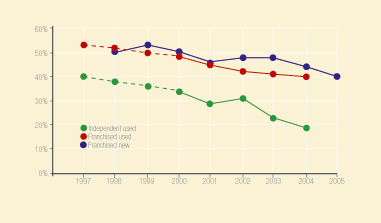The position is similar in the used car market, while the downward trend in point of sale (POS) finance demand is continuing, according to the latest figures from the Finance and Leasing Association (FLA). Finance provided for new car purchases fell 2% by value and 5% by volume compared with July 2004. In the business sector, demand for new car finance has waned in recent months, while the consumer new car market remains weak.
One effective answer to falling finance penetration is for dealers to employ a business or F&I manager, a policy which franchised dealers are adopting in increasing numbers since the mid-Nineties. Research for the Sewells New Car Finance House Survey found that 51% of dealers employed F&I managers, up around 10% on 2004. On average, their penetration was 42%, compared to 38% for dealers without a specialist.
The Sewells survey solicited responses on 71 finance houses from 897 franchised dealers, representing 41 marques at 1,195 outlets, each selling on average 423 new and 427 used cars a year.
In the first-ever New Car Finance Survey of 1995, dealers comments on their franchises’ finance subsidiaries were often highly critical, but now, 10 years later, views have changed for the better – although there was a slight increase this year in dealers’ comments betraying resentment at being ‘tied’.
Car manufacturers dominate the market for new car finance. This year, 84% of the 897 franchised dealers surveyed said their principal finance house was that of their manufacturer – compared to 80% in 2004, 88% in 2003, 92% in 2002 and 87% in 2001. For the 825 dealers putting business to more than one finance house, the principal provider supplied 83% of financed units.
The survey reveals that dealer satisfaction with their finance houses might have peaked. In the first New Car Finance House Survey, in 1995, it was 67.6% – between ‘average’ and ‘good’. This overall rating remained broadly stable until the year 2000.
The surveys from 2000 to 2004 saw the overall rating increase from 69.5% to 78.5%, on the way to ‘very good’. However, this year the overall rating for all finance houses fell back slightly to 77%. There was also a small increase in the percentage of respondents expressing a desire to change their principal new car finance house, from 10.9% in 2004 to 11.5% this year.
The highest rated grouping of the six performance elements this year (financial products, service levels, support, call centres, online systems and business relationships) was online systems, as in 2004. Yet only 38% of this year’s respondents use finance house call centres, and even this percentage is thought to overstate the case.
The second highest rated grouping was service. Ratings increased in eight of the nine areas of finance house service to dealers common to 2004 and 2005.
Average ratings on the 10 business relationship questions fell, however. This category includes documentation fees, a topic that records the lowest rating of all questions, while other business relationship questions including commission levels, early settlement terms, incentives/volume bonus scheme and interest rates charged for new car stocking finance – all of which were rated poorly. Respondents’ ratings of the competitiveness of new car consumer rates have been very low over the last three years.
Falling dealer finance penetration, 1997-2005

While the overall picture is poor, dealers employing F&I managers now enjoy 42% penetration compared to 38% for dealers without.












Login to comment
Comments
No comments have been made yet.